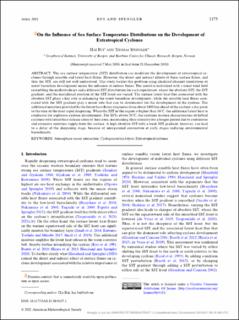| dc.contributor.author | Bui, Hai Hoang | |
| dc.contributor.author | Spengler, Thomas | |
| dc.date.accessioned | 2021-06-24T09:21:18Z | |
| dc.date.available | 2021-06-24T09:21:18Z | |
| dc.date.created | 2021-01-09T13:58:15Z | |
| dc.date.issued | 2021 | |
| dc.identifier.issn | 0022-4928 | |
| dc.identifier.uri | https://hdl.handle.net/11250/2761069 | |
| dc.description.abstract | The sea surface temperature (SST) distribution can modulate the development of extratropical cyclones through sensible and latent heat fluxes. However, the direct and indirect effects of these surface fluxes, and thus the SST, are still not well understood. This study tackles this problem using idealized channel simulations of moist baroclinic development under the influence of surface fluxes. The model is initialized with a zonal wind field resembling the midlatitude jet and a different SST distribution for each experiment, where the absolute SST, the SST gradient, and the meridional position of the SST front are varied. The surface latent heat flux associated with the absolute SST plays a key role in enhancing the moist baroclinic development, while the sensible heat fluxes associated with the SST gradient play a minor role that can be detrimental for the development of the cyclone. The additional moisture provided by the latent heat fluxes originates from about 1000 km ahead of the cyclone a day prior to the time of the most rapid deepening. When the SST in this region is higher than 16°C, the additional latent heat is conducive for explosive cyclone development. For SSTs above 20°C, the cyclones feature characteristics of hybrid cyclones with latent heat release close to their core, maintaining their intensity for a longer period due to continuous and extensive moisture supply from the surface. A high absolute SST with a weak SST gradient, however, can lead to a delay of the deepening stage, because of unorganized convection at early stages reducing environmental baroclinicity. | en_US |
| dc.language.iso | eng | en_US |
| dc.publisher | American Meteorological Society | en_US |
| dc.rights | Navngivelse 4.0 Internasjonal | * |
| dc.rights.uri | http://creativecommons.org/licenses/by/4.0/deed.no | * |
| dc.title | On the Influence of Sea Surface Temperature distributions on the Development of Extratropical Cyclones | en_US |
| dc.type | Journal article | en_US |
| dc.type | Peer reviewed | en_US |
| dc.description.version | publishedVersion | en_US |
| dc.rights.holder | Copyright 2021 American Meteorological Society | en_US |
| cristin.ispublished | true | |
| cristin.fulltext | postprint | |
| cristin.qualitycode | 2 | |
| dc.identifier.doi | 10.1175/JAS-D-20-0137.1 | |
| dc.identifier.cristin | 1868167 | |
| dc.source.journal | Journal of the Atmospheric Sciences | en_US |
| dc.source.pagenumber | 1173–1188 | en_US |
| dc.relation.project | Norges forskningsråd: 262220 | en_US |
| dc.subject.nsi | VDP::Meteorologi: 453 | en_US |
| dc.subject.nsi | VDP::Meteorology: 453 | en_US |
| dc.identifier.citation | Journal of the Atmospheric Sciences. 2021, 78(4), 1173–1188 | en_US |
| dc.source.volume | 78 | en_US |
| dc.source.issue | 4 | en_US |

